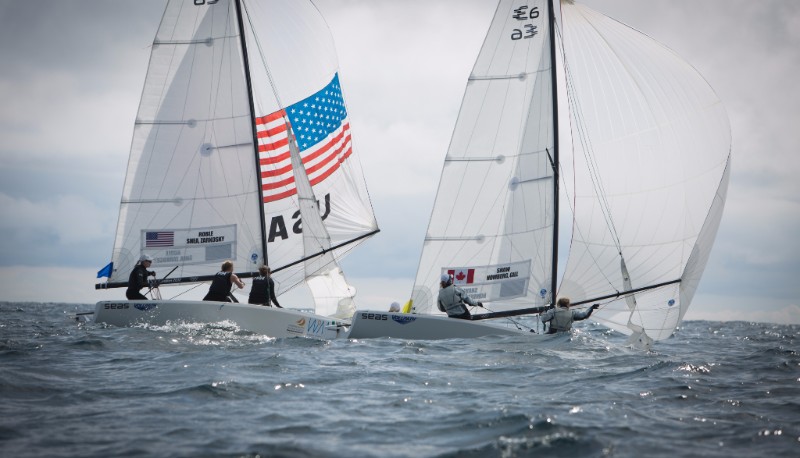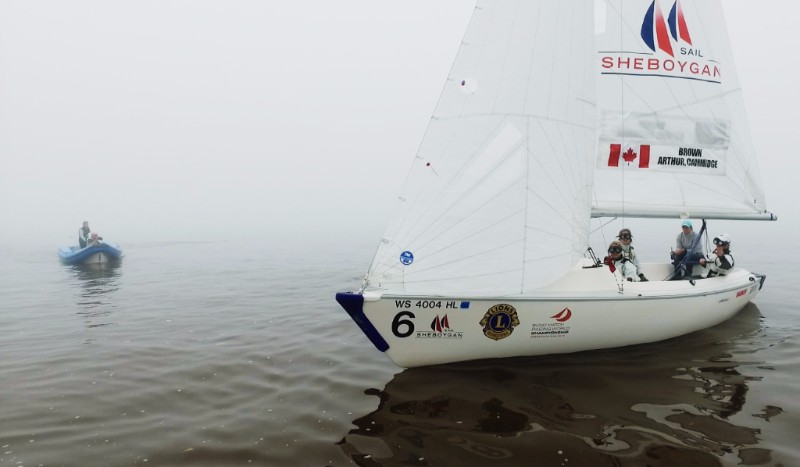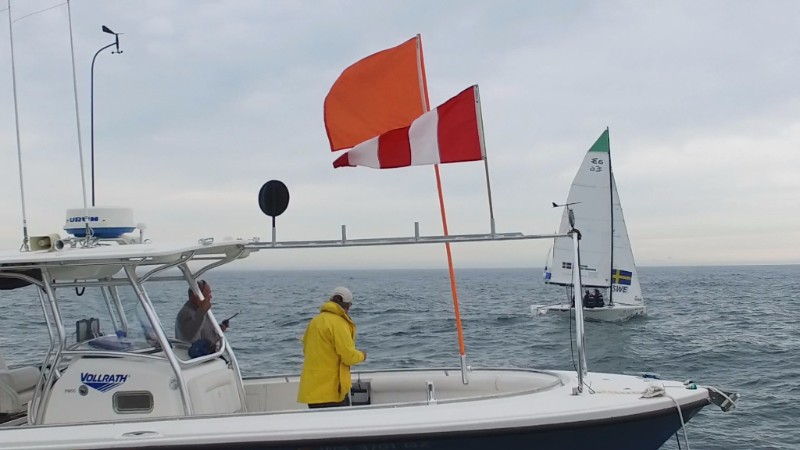If you’ve ever wondered what World Championship match racing sailors do during their downtime, here is the challenge Epic Racing threw down for their international competitors.

Sep 24
If you’ve ever wondered what World Championship match racing sailors do during their downtime, here is the challenge Epic Racing threw down for their international competitors.
Sep 23

Stephanie Roble and her Epic Racing (left) is leading the Buddy Melges Challenge, the 3rd event of the 2016 WIM Series and also the Women’s World Match Racing Championship, in Sheboygan after the first day of sailing. Photo: Niklas Axhede/WIM Series.
The Buddy Melges Challenge, the 3rd event of the 2016 WIM Series and also the Women’s World Match Racing Championship, finally got underway Friday. With a dozen flights sailed, Wisconsinite Stephanie Roble has taken the lead on her home waters of Lake Michigan.
“We had a lot of fun and some really close matches today” she said.
Two days with no racing in Sheboygan, due to fog and very shifty or no wind at all, really put the sailors to the test, wandering around on shore longing for wind and waves. But as the sun rose over Lake Michigan on Friday morning, a stable northerly breeze around 12 – 14 knots filled the racecourse just east of the Sheboygan South Pier.
“That was certainly worth waiting for,” said World Sailing Technical Delegate Alfredo Ricci from Italy, in USA for the week to supervise the event.
The race management used the excellent sailing conditions to make up for the lost days, completing as many as a dozen flights of four matches each.
Local hope Stephanie Roble and her Epic Racing crew of Maggie Shea and Janel Zarkowsky mastered the somewhat choppy and lumpy waters in a formidable way, posting a 10 – 1 score to sit alone at the top of the leader board after this first day of racing. The American team were all sunshine but very tired, arriving at the dock after no less than eight hours on the water.
“It was a lot of fun in good conditions out there, and I’m really happy with how our day went. I think we were getting off the line pretty well” Roble said, praising her crew for their hard work. “Our boat handling was definitely an advantage for us. It was hard going in all of the chop, but the girls kept the boat rolling and let me concentrate on driving.”
World #3 Anne-Claire Le Berre was the only one to beat Roble. The French skipper finished last year with a win in the Busan event, for a podium position on the 2015 WIM Series. After a maternity leave during the start of this season, she’s now back in full swing. With her 8 – 2 score so far in the round-robin stage, she’s sharing third place in the regatta with Renée Groeneveld, The Netherlands.
“It was a long day on the water and I’m happy we lost just two matches, as we were quite exhausted at the end” Le Berre said, explaining what cost them the two matches. “Boathandling, tactics and speed worked pretty well on board, but as we haven’t sailed very much this year, we lose matches when we’re making too many mistakes.”
Anna Östling of Sweden may be World #1, but on Lake Michigan she learned that Roble was the superior skipper — at least in their two Friday fights.
“In the first match we had Stephanie until the last downwind, where she surfed away on a big wave that we missed. And when we met her again in the afternoon, we hadn’t adjusted the trim on our boat for the slightly lighter winds, so she slipped away again,” Östling said, though she was not too worried about the two defeats. “No, I think it’s good with tight racing on a high level. We’ve learned a lot that we’ll use over the weekend.”
The double round-robin will be concluded Saturday and followed by quarterfinals, with the semi finals and the final to be decided on Sunday.
Standings in the round-robin of the Buddy Melges Challenge in Sheboygan, USA, the 3rd event of the 2016 WIM Series and also the Women’s World Match Racing Championship (skipper, country, wins – losses):
1. Stephanie, Roble, USA, 10 – 1
2. Anna Östling, SWE, 9 – 2
3. Renée Groeneveld, NED, 8 – 2
3. Anne-Claire Le Berre, FRA, 8 – 2
5. Samantha Norman, NZL, 4 – 6
6. Pauline Courtois, FRA, 4 – 7
7. Nicole Breault, USA, 3 – 8
8. Caroline Sylvan, SWE, 2 – 9
9. Elizabeth Shaw, CAN, 0 – 11
Sep 22

Canadian Elizabeth Shaw was one of the sighted skippers of the Buddy Melges Challenge, the 3rd event of the 2016 WIM Series and also the Women’s Match Racing World Championship, who were challenged by Vicki Sheen, British skipper from the Blind Match Racing World Championship in Sheboygan. Photo: Niklas Axhede/WIM Series.
Fog and lack of wind continue to cause problems for the Buddy Melges Challenge, the third event of the 2016 WIM Series and also the Women’s Match Racing World Championship. In the difficult Thursday conditions, Principal Race Officer Rich Reichelsdorfer couldn’t get any racing at all going:
“It looked good for a little bit around midday, but then the fog rolled in again,” he said.
However, there is one category of sailors in Sheboygan right now that don’t care at all about the fog. As a matter of fact they don’t even care about darkness. They’re simply ready to go match racing in any visibility conditions. Who are they? The blind sailors from five nations who are in Sheboygan for their Blind Match Racing World Championship, run parallel to the women’s event. But unfortunately they need sighted people to put out their buoys, set a proper course and umpire the racing, so they weren’t allowed to race on Thursday either.
Instead of match racing on Lake Michigan, the sailors gathered Thursday afternoon at the Sheboygan Yacht Club courtyard. There the blind sailors through land exercises demonstrated and gave the sighted women sailors some insight into how their match racing works. First of all the blind sailors have the same course, the same umpires and pretty much the same set of rules as the sighted women sailors. And they are sailing the slightly different Sonar boats instead of the Elliott 6Ms. The really big difference is that they use a number of different sounds to mark their racing course, as well as to describe what tack each boat is sailing on.
The sighted sailor, who thinks it’s enough of a problem to sort out the normal sound signals from the committee boat, may have become just a little bit more confused during the demonstration. The blind sailors are forced to keep all the following signals in mind:
To distinguish all these signals is hard for any sailor on a shore demonstration, but proves even worse out there on the water. An experience some of the sighted sailors got as they, with completely black goggles covering their eyes, went out to sail practice races against a blind team led by British skipper Vicki Sheen.
“Your world is what you feel underneath you, and with your fingertips,” she said. “You’re feeling everything through your hands and through your body, since you’ve got such a reduced visual sense.”
For Canadian sighted skipper Elizabeth Shaw, the practice race against the blind team was, if we may call it so, an eye-opener.
“We had the two marks beeping, we had the tweeting boxes going off on our boat and on their boat, and then there was a fog horn going off, and then there was a bit of noise within our boat and motorboats going around. It got very confusing, very quickly,” she said.
“It’s pretty incredible what those athletes are able to achieve and focus on. Everybody has a job on board, it’s just like what we do, but you take away your sense of sight,” she said.
So the day was not completely wasted, as the blind racers earned new respect from the top women match racers at the World Championship.
Sep 22
Recently I was fortunate to have the opportunity to run a North U Match Racing Clinic for the vision impaired sailors preparing for the 2016 World Sailing Blind Match Racing World Championship, being held at the Sheboygan Yacht Club in Sheboygan, Wisconsin, September 21-25, 2016, and sponsored by Sail Sheboygan and SEAS. Four teams participated, coming from California, Canada, Great Britain, and a team composed of sailors from Massachusetts and Sheboygan. Though each team had a sighted coach, they race with no sighted person on board. Truly amazing!
The clinic was in the Sonars they are racing in the Worlds, with three sailors to a boat. The skipper is required to be 100% blind, and the two others can have varying degrees of vision impairment. They had some goggles I could wear to experience what their vision ability was like. One common view is like looking through wax paper. You can make out shades and rough shapes, but there is no clarity. The other is like looking down a straw, but the straw is in a different place in each eye. They can see what they see clearly, but it is tiny. And they have no depth perception. Plus, if they lose sight of it, it takes them a while to search around to find it again.
They use two marks to form their starting line, each making a unique sound, and a windward mark with its own sound. They sail the traditional match racing course (W-L-W-Finish), but use the pin end of the starting line as the leeward mark. Each boat has a noise maker which makes a different sound on each tack.
In addition to the sounds of the marks, they have watches that beep and vibrate, and they are talking with each other as normal, so their world onboard is very loud! This is just one of their challenges. Another one is keeping track of where they are. If they lose track of the marks, they can get quite lost. And of course they need to be able to maintain the point of sail on which they want to sail. All this while trying to beat the other boat across the finishing line!
We spent most our time talking boat handling, speed and match racing tactics just like at all my other match racing clinics. We brainstormed ideas to address their challenges, and we had solid three-hour training sessions on the water filled with drills, practice starts and races, and lots of feedback. We did a session about the Sonar on the dock, and we simulated the prestart and sailing the course on land, using the marks and doing the walk-throughs in real time. On the water, they were good at sailing the correct angles, the skippers feeling the wind on their heads, the angle of heel, and hearing the boat go through the water, and the trimmers feeling the actual sail and the angle of the boom.
What I loved the most was that every sailor and team was committed to improving, and to sharing their own experiences for the benefit of the others. Everyone’s attitude was that they were a group of sailors trying to get better at sailing and match racing, and their vision was just part of the puzzle to solve to become more successful. Each one of them loves sailing and being out on the water, and the challenge of racing. No different than any of us who love the sport.
To go sailing and racing, all these vision impaired sailors need is an invitation or some support from someone to be included in that person’s sailing experience. My experience with this racing community could not have been more positive. I encourage others to seek out the same positive experience by reaching out and including them as well. It is truly a win-win situation!
Sep 21
 “If you don’t like the weather in Sheboygan, just wait 15 minutes.”
“If you don’t like the weather in Sheboygan, just wait 15 minutes.”A warm front with strong winds, thunder and heavy rain passed Sheboygan early Wednesday morning, leaving behind not only very unstable conditions, but also occasional fog.
The very challenging weather conditions really put the regatta organizers to the test. After an hour’s postponement in the foggy morning, the sailors were sent out on Lake Michigan, just to learn that wind shifts of 90–180 degrees made it impossible for the race management to set a proper course.
A few matches got into starting sequence, but none could be sailed all the way to the finish. Sailors were sent ashore again to wait, and at 3 p.m. Rich Reichelsdorfer canceled all racing for the day.
“We’re expecting a new front within just a few hours, so it’s better to get all set before that front arrives,” he said.
For Samantha Norman from New Zealand, the difficult weather in Sheboygan was no surprise. She won the very first edition of the Buddy Melges Challenge, back in 2009, and finished runner-up behind Australian Nicky Souter the year after that.
“I think it was pretty similar conditions the last time we were here. Nice and foggy with shifty winds and big waves,” Norman said, still happy to be back on Lake Michigan for some match racing.
“We haven’t matched up against these girls for a number of years now, so we’ll just do our best out there and we’ll see what happens” she said.
Given the circumstances, the double round-robin will now have to begin Thursday instead, followed by quarterfinals, and then the semis and the final matches over the weekend. There are no plans yet to change the event format.
“No, we’re still early in a five-day regatta, so we’ll just wait and see” Rich Reichelsdorfer said.
Sep 21
Sep 21